Ali Muhammad
CBAM-SwinT-BL: Small Rail Surface Detect Detection Method Based on Swin Transformer with Block Level CBAM Enhancement
Sep 30, 2024



Abstract:Under high-intensity rail operations, rail tracks endure considerable stresses resulting in various defects such as corrugation and spellings. Failure to effectively detect defects and provide maintenance in time would compromise service reliability and public safety. While advanced models have been developed in recent years, efficiently identifying small-scale rail defects has not yet been studied, especially for categories such as Dirt or Squat on rail surface. To address this challenge, this study utilizes Swin Transformer (SwinT) as baseline and incorporates the Convolutional Block Attention Module (CBAM) for enhancement. Our proposed method integrates CBAM successively within the swin transformer blocks, resulting in significant performance improvement in rail defect detection, particularly for categories with small instance sizes. The proposed framework is named CBAM-Enhanced Swin Transformer in Block Level (CBAM-SwinT-BL). Experiment and ablation study have proven the effectiveness of the framework. The proposed framework has a notable improvement in the accuracy of small size defects, such as dirt and dent categories in RIII dataset, with mAP-50 increasing by +23.0% and +38.3% respectively, and the squat category in MUET dataset also reaches +13.2% higher than the original model. Compares to the original SwinT, CBAM-SwinT-BL increase overall precision around +5% in the MUET dataset and +7% in the RIII dataset, reaching 69.1% and 88.1% respectively. Meanwhile, the additional module CBAM merely extend the model training speed by an average of +0.04s/iteration, which is acceptable compared to the significant improvement in system performance.
Advanced Efficient Strategy for Detection of Dark Objects Based on Spiking Network with Multi-Box Detection
Oct 10, 2023Abstract:Several deep learning algorithms have shown amazing performance for existing object detection tasks, but recognizing darker objects is the largest challenge. Moreover, those techniques struggled to detect or had a slow recognition rate, resulting in significant performance losses. As a result, an improved and accurate detection approach is required to address the above difficulty. The whole study proposes a combination of spiked and normal convolution layers as an energy-efficient and reliable object detector model. The proposed model is split into two sections. The first section is developed as a feature extractor, which utilizes pre-trained VGG16, and the second section of the proposal structure is the combination of spiked and normal Convolutional layers to detect the bounding boxes of images. We drew a pre-trained model for classifying detected objects. With state of the art Python libraries, spike layers can be trained efficiently. The proposed spike convolutional object detector (SCOD) has been evaluated on VOC and Ex-Dark datasets. SCOD reached 66.01% and 41.25% mAP for detecting 20 different objects in the VOC-12 and 12 objects in the Ex-Dark dataset. SCOD uses 14 Giga FLOPS for its forward path calculations. Experimental results indicated superior performance compared to Tiny YOLO, Spike YOLO, YOLO-LITE, Tinier YOLO and Center of loc+Xception based on mAP for the VOC dataset.
Optimizing Information Freshness Leveraging Multi-RISs in NOMA-based IoT Networks
Aug 02, 2022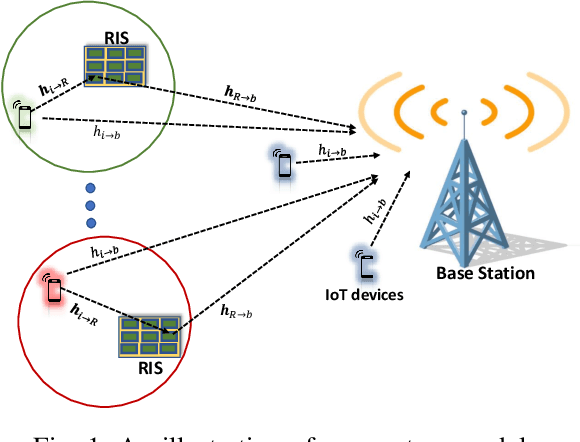

Abstract:This paper investigates the benefits of integrating multiple reconfigurable intelligent surfaces (RISs) in enhancing the timeliness performance of uplink Internet-of-Things (IoT) network, where IoT devices (IoTDs) upload their time-stamped status update information to a base station (BS) using non-orthogonal multiple access (NOMA). Accounting to the potential unreliable wireless channels due to the impurities of the propagation environments, such as deep fading, blockages, etc., multiple RISs are deployed in the considered IoT network to mitigate the propagation-induced impairments, to enhance the quality of the wireless links, and to ensure that the required freshness of information is achieved. In this setup, an optimization problem has been formulated to minimize the average sum Age of Information (AoI) by optimizing the transmit power of the IoTDs, the IoTDs clustering policy, and the RISs configurations. The formulated problem ends up to be a mixed-integer non-convex problem. In order to tackle this challenge, the RISs configurations are first obtained by adopting a semi-definite relaxation (SDR) approach. Then, the joint power allocation and user-clustering problem is solved using the concept of bi-level optimization, where the original problem is decomposed into an outer IoTDs clustering problem and an inner power allocation problem. Optimal closed-form expressions are derived for the inner problem and the Hungarian method is invoked to solve the outer problem. Numerical results demonstrate that our proposed approach achieves lowest AoI compared to the other baseline approaches.
Optimizing Information Freshness in RIS-assisted NOMA-based IoT Networks
Feb 28, 2022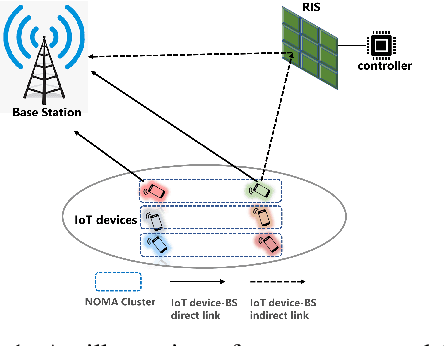

Abstract:This paper investigates the benefits of integrating reconfigurable intelligent surface (RIS) on minimizing the average sum age of information (AoI) in uplink non-orthogonal multiple access-based Internet-of-Things (IoT) networks. In this setup, an optimization problem is formulated to optimize the RIS configuration, the transmit power per IoT device and the clustering policy of IoT devices. The formulated problem is a mixed-integer non-convex one, and in order to solve it we obtain first the RIS configuration by adopting a semi-definite relaxation (SDR) approach. Afterwards, the joint power allocation and user-clustering problem is solved using the concept of bi-level optimization and is decomposed into an outer user clustering problem and an inner power allocation problem. Optimal closed-form expressions are derived for the inner problem and the Hungarian method is employed to solve the outer one. Numerical results demonstrate the performance superiority of our approach.
Age of Information Optimization in a RIS-Assisted Wireless Network
Mar 11, 2021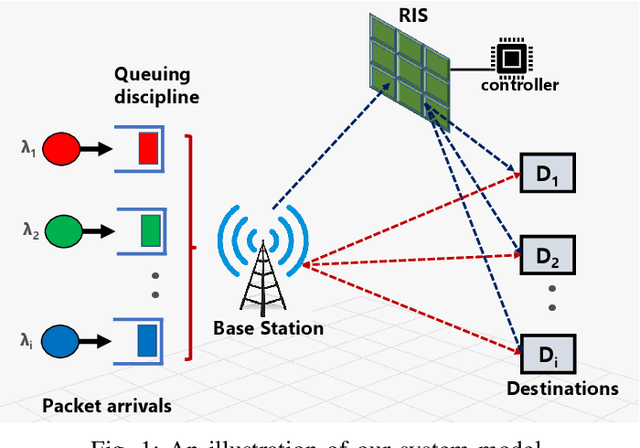

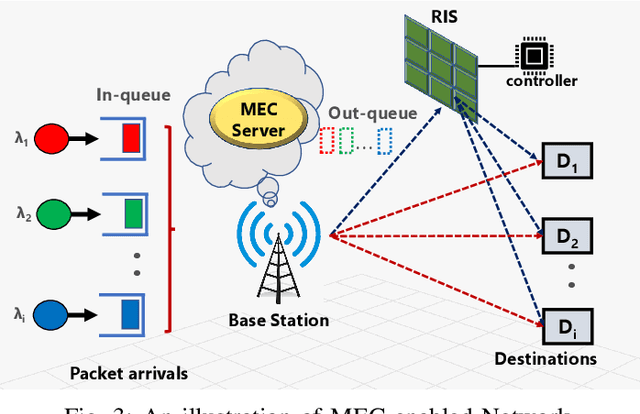
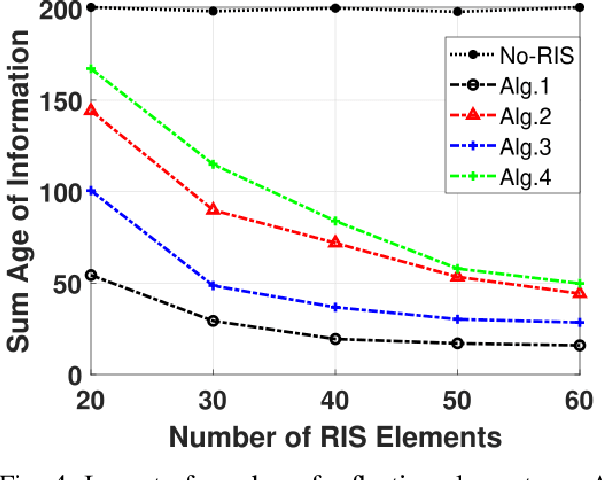
Abstract:Future wireless communication networks are envisioned to revolutionize the digital world by offering super-low latency, unrivalled speed and reliable communication. Consequently, a myriad of propitious applications such as augmented/virtual reality, industry 4.0, etc., is anticipated to flourish. These applications rely on real-time information to make critical decisions and hence the temporal value of information generation and dissemination carries a paramount importance. One of the acute challenges restraining to unleash the full potentials of these applications is the time-varying wireless communication environment implying the unpredictable fading effects. In this paper, we consider a wireless network consisting of a base stations (BS) that is serving multiple traffic streams to forward their information updates to the destinations over an unreliable wireless channel. We study the benefits of utilizing reconfigurable intelligent surface (RIS) to mitigate the propagation-induced impairments of the wireless environment, enhance the link quality and ensure that the required freshness of information is achieved for the real-time applications. To quantify the freshness of information at each destination, we utilize the concept of Age of Information (AoI). AoI is determined by the time for a fresh update to arrive to its queue at the BS till it is successfully received at the destination. A joint RIS phase shift and scheduling optimization problem is formulated with the goal of minimizing the AoI. In order to solve this optimization problem, we propose an efficient algorithm based on semi-definite relaxation (SDR). We then extend our proposed system model and studied a use-case of real-time edge video analytics utilizing multi-access edge computing (MEC) system. Finally, we perform extensive simulations to verify the effectiveness of our proposed methods against other approaches.
 Add to Chrome
Add to Chrome Add to Firefox
Add to Firefox Add to Edge
Add to Edge